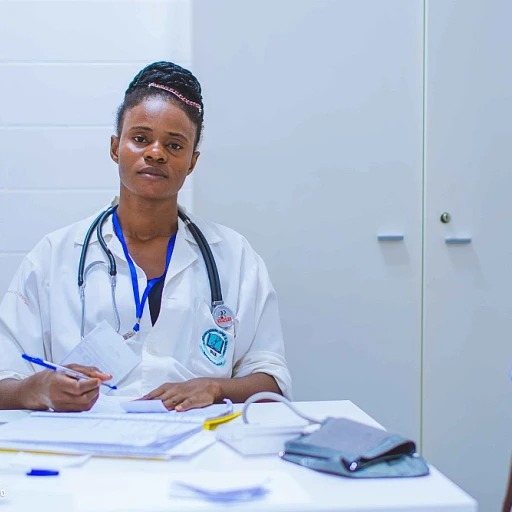Defining Leadership Team Development
Recognizing the Importance of Leadership Team Development
In today's fast-paced business environment, organizations increasingly acknowledge the value of effective leadership teams. This process of leadership team development is instrumental in aligning team members toward common goals and enhancing overall organizational success. A leadership team is more than just a collection of individuals holding executive positions; it is about building a cohesive unit where every member feels empowered to contribute to decision-making processes. Unlike traditional management approaches, leadership team development focuses on fostering a harmonious work environment where communication is open and strategies are collaboratively crafted. It emphasizes team building by honing individual leadership skills and broadening the collective capabilities of the team. Through targeted development programs, team members learn to navigate high-pressure situations and lead their teams towards sustainable growth. The senior leadership of an organization has a critical role in shaping its future by continually refining their leadership skills through ongoing learning and training. For businesses seeking to enhance their leadership team's effectiveness, understanding the fundamentals of team leadership is essential. It involves fostering trust among team members, encouraging innovative thinking, and instilling a strong sense of purpose across the team's ranks. In the journey of leadership development, adopting a strategic approach allows for the creation of tailored development plans that address specific organizational needs. This strategic process, which includes goal-setting, skill-building, and regular feedback, not only strengthens the leadership team but also aligns them with the organization’s objectives. For those interested in further exploring strategies to elevate team performance, consider visiting this insightful resource.The Role of Upskilling in Leadership
The Importance of Cultivating Skills in Leadership
In today's rapidly evolving business landscape, effective leadership is more critical than ever. Leaders play a pivotal role in guiding their teams through challenges and towards opportunities, making the continuous development of their skills indispensable. This necessity for growth highlights the value of upskilling within leadership teams, particularly as they navigate complex environments and drive their organizations forward.
For any organization, the process of upskilling involves a strategic approach to equip team members with the competencies required to meet current and future demands. In the realm of leadership development, this process is essential for building high-performing teams capable of addressing the needs of both the business and its employees. By focusing on individual and collective leadership skills, organizations can foster a culture of strong leadership that permeates the executive team and the broader workforce.
Leadership development programs offer a structured approach to enhance skills such as decision-making, team-building, and executive leadership. When leaders are exposed to targeted training, they are better prepared to guide their teams in an effective and cohesive manner, inspiring high performance and mutual trust among team members. Additionally, executive team leaders need to commit to continuous learning, embracing new tools and techniques to cultivate an environment where development is ongoing.
The role of upskilling extends beyond individual growth; it supports the strategic objectives of the organization. A well-developed leadership team contributes to a more adaptable organization, one that can pivot when necessary and capitalize on emerging market trends. Upskilling supports a growth mindset, ensuring leaders remain at the forefront of their industry and are equipped to handle the multifaceted challenges they encounter.
To initiate a leadership development plan, business executives must assess the organization's current capabilities and align development goals with overall business objectives. Engaging in this strategic alignment can lead to more meaningful performance reviews. Learn how crafting effective leadership goals for performance reviews can create impactful assessments that drive leadership development forward.
Key Components of Effective Leadership Teams
Essential Elements for Thriving Leadership Teams
Building effective leadership teams is a multifaceted process requiring commitment, strategic planning, and continuous development. These teams are pivotal in shaping the success of any organization, driving strategic initiatives, and achieving high-performance outcomes. To ensure leadership teams thrive, several key components must be emphasized. Strong Leadership At the core of effective leadership teams is strong leadership. Team leaders must possess the right leadership skills, with a focus on decision-making capabilities and vision execution. An adept leader will guide team members, fostering an environment of trust and collaboration. Diverse Skill Sets Leadership teams must incorporate diverse skill sets among their members. This diversity not only aids in innovative problem-solving but also ensures that the team has a comprehensive understanding of the business landscape. Encouraging continuous learning and development of skills within the team helps bridge any skill gaps that may arise. Clear Communication Effective communication is pivotal. Team members should be encouraged to express ideas freely, knowing that their input is valued. Communication fosters transparency and allows for better alignment with organizational goals. It's crucial to integrate communication training into leadership development programs to reinforce this. Collaborative Environment Creating a collaborative work environment where team members feel empowered to engage in team building activities boosts morale and strengthens relationships. This environment is essential for creativity and efficiency, as individuals are more likely to collaborate willingly when they perceive value in their contributions. Regular Training and Development Continuous training and development ensure that the leadership team remains agile and adaptable. Development plans should be a regular part of the executive team's agenda, addressing both individual and team growth. Programs should focus not just on leadership development but also on cultivating high-performing teams. [Enhancing skills through well-designed recognition programs] can be a significant part of this ongoing process. The role of upskilling in ensuring these components are effectively ingrained in leadership teams cannot be underestimated, as it empowers these teams to continuously evolve and overcome challenges that arise within organizations.Challenges in Developing Leadership Teams
Overcoming the Stumbling Blocks in Building Strong Leadership Teams
In every organization, the pathway to cultivating effective leadership teams is laden with challenges. Understanding what these challenges are is vital to implementing a successful development plan. One of the primary obstacles is aligning diverse leadership styles. Team leaders may have different approaches based on their backgrounds, experiences, and skill sets. This diversity, while potentially advantageous, can sometimes lead to conflicts, making the team development process more complex. Another critical challenge lies in the realm of communication. For a leadership team to function as a cohesive unit, clear and effective communication is essential. However, disparate communication styles or gaps in understanding can create hurdles in the decision-making process. Addressing these challenges requires targeted training and development programs that emphasize team building and effective communication skills. The fast-paced nature of the modern business environment poses another challenge. Teams are expected to quickly adapt and respond to ever-changing market demands. This can put pressure on leadership teams to continuously update their skills and knowledge. Emphasizing a culture of continuous learning within the organization and encouraging executive teams to engage in ongoing training can be instrumental in overcoming this challenge. Team members may also feel apprehensive about change in leadership dynamics or development plans. Such apprehensions can lead to resistance, which hinders the development process. Involving team members in the planning phase of development programs can help in alleviating fears and fostering a sense of ownership and commitment towards the goals. Finally, measuring the impact of leadership development itself is a significant hurdle. Determining what leadership aspects have improved can be nuanced, as it often blends with broader organizational success. Utilizing effective metrics and feedback mechanisms helps in assessing the impact and guiding future leadership development initiatives. Overall, embracing these challenges and addressing them head-on can pave the way for crafting effective leadership teams that drive high performance across the organization.Tools and Techniques for Leadership Upskilling
Innovative Approaches to Leadership Upskilling
Upskilling is a critical component in the development of effective leadership teams. With the rapid pace of change in the business environment, leaders must continually enhance their skills to keep up with new challenges and opportunities. Here are some tools and techniques that can help in the upskilling process:
- Workshops and Seminars: These are traditional yet effective methods for team development. They provide leaders with the opportunity to learn new skills and strategies in a focused environment. These sessions often include interactive components that encourage team members to engage with the material actively.
- Online Learning Platforms: With the rise of digital technology, online platforms have become a popular tool for leadership training. They offer flexibility and a wide range of courses that can be tailored to the specific needs of an organization. Leaders can learn at their own pace, making it easier to integrate training into their busy schedules.
- Mentorship Programs: Pairing less experienced team members with seasoned leaders can be an effective way to transfer knowledge and skills. This process not only helps in building strong leadership skills but also fosters a culture of continuous learning within the organization.
- Simulations and Role-Playing: These techniques allow leaders to practice decision-making and problem-solving in a controlled environment. By simulating real-world scenarios, team members can develop the skills needed to handle high-pressure situations effectively.
- Feedback and Assessment Tools: Regular feedback is essential for leadership development. Tools that provide constructive feedback can help leaders identify areas for improvement and track their progress over time. This ongoing process of assessment and feedback ensures that leaders are continually developing their skills.
Integrating these tools and techniques into a comprehensive development plan can significantly enhance the capabilities of leadership teams. By focusing on continuous learning and skill development, organizations can build high-performing teams that are well-equipped to lead in today's dynamic business landscape.
Measuring the Impact of Leadership Development
Evaluating the Success of Leadership Development Initiatives
Measuring the impact of leadership development is a fundamental step in ensuring that executive teams are truly benefiting from upskilling activities. The evaluation process requires a blend of qualitative and quantitative measures, offering insights into the actual improvements in leadership skills and effectiveness within the organization. First and foremost, it's crucial to establish clear objectives for each leadership development initiative. This ties directly into what leadership teams aim to achieve. Align these objectives with the organization's broader goals to ensure that the development aligns with business needs.- Leadership Performance Metrics: Quantitative assessment tools like 360-degree feedback surveys can help gauge improvement in decision-making and team leadership skills post-training. These tools collect feedback from multiple team members, providing a comprehensive picture of a leader's impact.
- Employee Engagement and Satisfaction: Surveys or interviews with team members can highlight any shifts in team morale or communication after leadership training. Strong leadership should result in high-performing teams where members feel engaged and valued.
- Business Performance Indicators: Examine business metrics such as productivity, revenue growth, and team efficiency. Effective leadership should positively influence these key performance indicators, demonstrating the tangible benefits of leadership skills development.
- Ongoing Learning and Development: Track participation in further training and team development programs. The commitment to continual learning reflects a successful upskilling process and a culture that values growth and adaptability.







